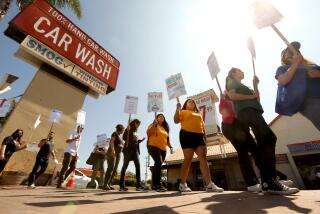Gov. Brown used political muscle to revive workers’ comp bill
- Share via
SACRAMENTO — A controversial workers’ compensation overhaul bill was all but dead last week. Then Gov. Jerry Brown stepped in.
In less than 24 hours — on Aug. 31, the final day of the Legislature’s session — Brown showed what decades of political experience can deliver on deadline. To rescue the massive package, he came up with a pot of extra money to help the most seriously injured workers. He personally met with recalcitrant state senators in his office and in the suite of Senate leader Darrell Steinberg (D-Sacramento) that morning. And to break the ice, he brought along Sutter, his brown-and-white Welsh Pembroke corgi.
The face-to-face lobbying was intense. He reminded Democrats about the 170-page bill’s benefits for injured workers, and Republicans were warned that without the bill, businesses faced up to 18% increases in workers’ compensation insurance. Brown got the votes he needed. By the end of the night, he had racked up unusually large, bipartisan majorities for the bill, SB 863, first in the state Assembly and finally in the Senate.
“There was a reluctance in part of the Legislature to take care of this. Many of them were not engaged,” Brown said in a telephone interview Friday as he recounted the turnaround.
“It was a tall hill … and I was able to bring it around,” he said.
The $17-billion-a-year workers’ compensation system is one of the biggest social insurance programs operated by the state. It covers practically every one of California’s 14.4 million employees working for 864,000 companies, governments and nonprofit organizations. Each year about 500,000 claims are filed, with about 1 in 8 qualifying for permanent disability benefits.
The workers’ compensation package emerged in public view late in the legislative session after months of negotiation between representatives of labor and large employers — with the blessing of the Brown administration.
In the last few weeks of the session, supporters built a coalition. At the same time, the opponents — who were shut out of early talks — began to rally opposition.
Remarkably, the bill’s entire legislative history amounted to three days of nonstop ups and downs last week. Its first legislative hearing occurred that Tuesday, and the bill cleared that Friday.
Brown’s potential troubles heightened early in that last week. The bill was being pummeled by lobbyists for groups whose members earn their livelihoods from the medical-legal bureaucracy that works with injured workers. They included lawyers, outpatient surgical centers, medical equipment manufacturers, chiropractors and drug dispensers, lobbying legislators in force.
Following a Thursday evening caucus meeting, Steinberg told a top administration official flat out that the proposal was in trouble. It wouldn’t get out of the Senate, he said, because it didn’t have enough votes from members of the Democratic majority.
One of Brown’s closest advisors, Labor and Workforce Development Agency Secretary Marty Morgenstern, warned the governor that the agreement was in jeopardy. “I was skeptical we could get it through the Senate,” Morgenstern said he told the governor.
“Let me try,” Brown replied, according to Morgenstern.
Brown’s efforts “were the key” to moving the bill, opposition leader Jesse Ceniceros, president of Voters Injured at Work, confirmed. “I honestly think it was influential what he did.”
Morgenstern and other key administration officials described the dizzying ups and downs of the bill in an interview with The Times on Friday.
The agreement that eventually emerged is expected to provide $740 million a year in new benefits for permanently disabled workers, starting next year, while reducing overall medical and compensation costs by 4%, said Christine Baker, the director of the state Department of Industrial Relations, who is a 27-year veteran of dealing with workplace regulation and laws.
Last-minute negotiations also created a special $120-million annual fund to provide extra benefits to people who have been catastrophically hurt and cannot return to their jobs.
Baker began work on the package last spring, first meeting separately with union officials and employers before bringing the two sides together.
Participants in the closed-door meetings included the California Labor Federation, the firefighters’ union, the state Building Trades Council, the Service Employees International Union and the Teamsters.
Sitting across from them were representatives of Walt Disney Co., Safeway Inc., Southern California Edison, UPS Inc., organic produce grower Grimmway Farms and a special government authority that provides insurance for public schools.
“We had union and nonunion, public and private” employers, Baker said. The combination of labor and management, plus the clout and persuasiveness of the governor, created a “phenomenal” alignment of the political stars, she said.
But selling that initial agreement took more than just the governor’s intervention, said Brown’s executive secretary, Nancy McFadden. In a series of separate meetings with labor unions and business groups, McFadden said, she “made it clear that the governor is willing to put his muscle behind the bill,” but only if the interested parties “fight for it and defend it.”
Now that the bill has passed and is awaiting the governor’s signature, the Brown administration is starting to work on crafting the rules and regulations needed to make it work.
“We want to get this done so its effect is immediate,” Morgenstern said. “We can’t realize the savings promised unless it’s done quickly.”
More to Read
Inside the business of entertainment
The Wide Shot brings you news, analysis and insights on everything from streaming wars to production — and what it all means for the future.
You may occasionally receive promotional content from the Los Angeles Times.











